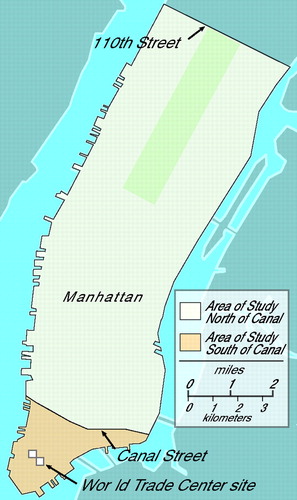Trauma Taking Its Toll on New Yorkers’ Mental Health
The section of Manhattan that runs from 110th Street to the World Trade Center is about seven miles long. Following the September 11 attacks, trauma experts anticipated, based on previous research, that some residents of this area would develop symptoms of posttraumatic stress disorder (PTSD) or depression.
A team of researchers led by Sandro Galea, M.D., and David Vlahov, Ph.D., at the New York Academy of Medicine found that 8 percent of a random sample of 988 Manhattan residents reported current symptoms of PTSD, and 10 percent reported current symptoms of depression. Current was defined as within 30 days prior to being interviewed five to nine weeks after the attacks.
Four percent of the sample reported symptoms of both PTSD and depression, according to the March 28 New England Journal of Medicine.
The sample was interviewed by telephone between October 15 and November 16.
“These prevalence rates suggest that in the area below 110th Street approximately 67,000 persons had PTSD and approximately 87,000 had depression at the time of the study,” said Galea in an interview.
The researchers used modified versions of the Diagnostic Interview Schedule for PTSD and the Structured Clinical Interview for DSM-IV for major depressive disorder. The symptoms for PTSD must have continued for at least two weeks, Galea said.
Fifty-two percent of the respondents were women, and the mean age was 42. The ethnic breakdown was 72 percent white, 12 percent Hispanic, 8 percent Asian, 6 percent black, and 2 percent “other.”
 Significant predictors of PTSD symptoms were Hispanic ethnicity, symptoms of a panic attack during or soon after the disaster, two or more stressors in the 12 months before September 11, possessions damaged by the attacks, and living south of Canal Street (see map).
Significant predictors of PTSD symptoms were Hispanic ethnicity, symptoms of a panic attack during or soon after the disaster, two or more stressors in the 12 months before September 11, possessions damaged by the attacks, and living south of Canal Street (see map).
Significant predictors of depression were Hispanic ethnicity, loss of job or the death of a relative or friend due to the attacks, the occurrence of a panic attack during or soon after the disaster, and two or more stressors in the 12 months prior to September 11. Galea said that prior stressors included the death of a spouse or partner, death of a close family member, and divorce or marriage. Another significant predictor was a low level of social support in the six months prior to September 11.
Carol North, M.D., a member of the APA Committee on Psychiatric Dimensions of Disasters, said in an interview, “The results show some evidence of psychopathology and distress, but we don’t know yet whether that will translate into serious psychiatric disorders.”
North was the lead investigator of a study of psychiatric disorders among 182 adults who survived the 1995 Oklahoma City bombing after having been directly in the path of the blast. The study was published in the August 25, 1999, Journal of the American Medical Association.
Her team of researchers found that six months after the bombing, 44 percent of the survivors had PTSD based on DSM-IV criteria. Factors that predicted a diagnosis of PTSD included female sex, exposure to the bombing, and a prior psychiatric disorder. The rate of PTSD in subjects without a previous psychiatric disorder was 26 percent.
The NEJM article stated that the rate of PTSD symptoms was about 10 percent in the 370 respondents who directly witnessed the terrorist attacks. Of those who did not directly witness the attacks, the rate was 5 percent. In addition, 111 of the 988 respondents who were involved in the rescue efforts at the World Trade Center had three times the rate of PTSD symptoms than those who were not involved.
The article did not note whether respondents had pre-existing PTSD or depression, which might have contributed to their “current” diagnosis, or whether they had sustained physical injuries from being involved in rescue efforts.
Aside from the different timeframes in their studies, North and Galea said comparing their results would not be meaningful because they used different diagnostic criteria for PTSD and depression in their studies.
North used the Diagnostic Interview Schedule/Disaster Supplement based on DSM-IV criteria to determine the presence of psychiatric disorders among survivors of the Oklahoma City bombing about six months later. The DSM-IV criteria for PTSD state that a person must have experienced or be directly exposed to a life-threatening event, had difficulty functioning in at least one area, and had symptoms of hyperarousal, avoidance, and re-experiencing the trauma for more than one month.
Galea said his team of researchers used “conservative” criteria for PTSD and depression, that is, “nonevent specific.” He said the team decided to use Manhattan residents as the sample population rather than solely people who were physically present at the World Trade Center and survived the attacks. Interviewing these survivors, said Galea, “would have been difficult to do so soon after the attacks because we were interviewing them outside of the therapeutic context.”
The Manhattan respondents were asked at the end of their interviews, however, whether they wanted to see a counselor. Those who said yes were connected with one, said Galea.
The research team is completing a six-month assessment of a sample of residents of New York City, Long Island, and New Jersey. “We plan to follow a subset of this sample up to 24 months,” said Galea.
An abstract of the article, “Psychological Sequelae of the September 11 Terrorist Attacks in New York City,” is posted on the Web at http://content.nejm.org/cgi/content/abstract/346/13/982. ▪
N ENGL J MED 2002 346 982



